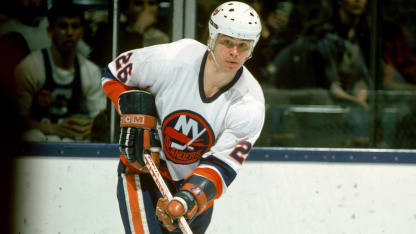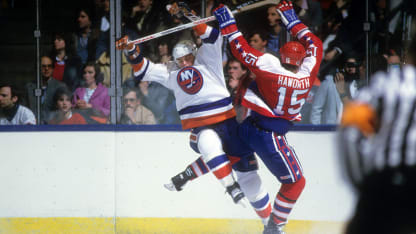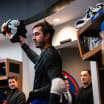Coach Al Arbour wisely teamed Bam Bam with the more offense-minded Stefan Persson. It was a perfect blend and each of the D-men understood his role.
"Sure, I would have liked to do more things offensively," Langevin recalled. "But my basic role was to play defense, be in position so that Stefan could carry the puck."
Drafted by the Islanders in 1979 after Dave did his basic training in the World Hockey Association with the Oilers, Langevin almost was retained by Edmonton in the Expansion Draft following the NHL-WHA merger.
"The Oilers were allowed to protect two players," Isles GM Bill Torrey recalled. "Obviously, one of them had to be Wayne Gretzky. Glen Sather had to make a decision on one of two players.
"It would either be a Swedish forward, Bengt Gustafsson, or Dave Langevin. So, we held our breath and wound up very happy that Slats took Bengt and we got Dave."
As a rookie among the Nassaumen, Langevin joined a team that still was striving for its first Stanley Cup. No question, Dave proved a difference-maker along with acquisitions Ken Morrow, Butch Goring and Gord Lane.
Torrey's chief scout, Jim Devellano, had eyed Langevin as far back as Dave's years playing the blue line at the University of Minnesota-Duluth.
"It took a while," said Jimmy D, now Executive Vice President of the Detroit Red Wings, "but Dave developed into one of the premier defensive defensemen in the league.
"He learned to use his body which had become a rarity in the early 1980's. He played a thinking man's game. Always probing, anticipating plays and breaking them up."
It wasn't merely Dave's employers or teammates who heaped praise on Langevin. Opposition general managers wished that Dave was on their roster. One was Craig Patrick, then GM of the Rangers.
"It was Dave's misfortune that everybody was noticing defensemen with the big scoring stats," said Patrick. "But if you asked me if he would be on my All-Star Team, the answer would be 'Yes.'"
As the Islanders grew from a one-Cup to a two-Cup and a three-Cup team, Langevin's talents became known throughout the NHL.
In 1981, his plus-minus rating was up at plus-40 and a year later it still was up there at plus-34. Many believed that the arithmetic should have qualified him for an All-Star nomination.
Langevin: "In 1981 everybody said I had an All-Star berth clinched. But Pat Quinn of Philadelphia was the coach and he picked one of his own players, Behn Wilson.
"I felt I was deserving, but I also realized that there was nothing I could do so I didn't worry about it. I went out every game and did the best I could."
It was so good that in 1993, Dave was voted into the U.S. Hockey Hall of Fame. Upon his induction, a reporter asked him to describe what made the four-Cup Islanders so good.
"I found it hard to say how great our team was while being a part of it," Dave asserted. "All I know is that our practices were a lot harder than a lot of our games."
Because of his endless rugged play, Langevin's body took a beating. A devastating knee injury nearly ended his career, but he eventually recovered.
While always minimizing his offensive assets, the fact remains that Dave scored one of the most decisive goals in Islanders history on April 21, 1982 at Madison Square Garden.
With his Isles leading the series three games to two, Game Six was tied 3-3 in the third period when Langevin fired a 50-footer past goalie Ed Mio.
It turned out to be both the game-winner and series-clincher after Bob Bourne added an empty-netter for the 5-3 decision.
"I don't get many goals," Dave laughed in the winner's dressing room, "but anybody on this team can come up big at any time. I've taken a lot of shots like this one before and they were saved. This time, it went in."
Those who knew Langevin best were not surprised that he became an Islanders hero. He had a highly successful scholastic hockey career in St. Paul.




















